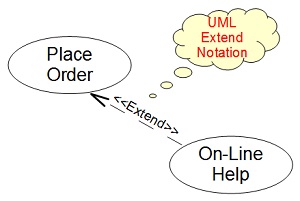UML Tutorials - Herong's Tutorial Examples - v1.05, by Herong Yang
Use Case Diagram - Extend Notation
This section describes the Extend Notation used in a UML Use Case Diagram. An Extend Notation presents an extension relation between two use cases where one acts as the base use case and the other acts as an add-on use case.
An Extend Notation is a graphical notation used in a UML Use Case Diagram to represent an extension relation between two use cases where one acts as the base use case and the other acts as an add-on use case. The base use case is usually called the Extended Use Case. The add-on use case is usually called the Extending Use Case.
An Extend Notation is usually drawn as a dash line with a line arrow connecting both use cases. The arrow of an Extend Notation should point to the extended use case. An Extend Notation should also be labeled with the "<<extend>>" key word.
For example, the "On-Line Help" use case is an extension to the "Place Order" use case. This extension relation can be drawn as an Extend Notation in a UML use case diagram as shown below:

Table of Contents
Introduction of UML (Unified Model Language)
UML Class Diagram and Notations
UML Activity Diagram and Notations
UML Sequence Diagram and Notations
UML State Machine Diagram and Notations
►UML Use Case Diagram and Notations
Use Case Diagram - Use Case Notation
Use Case Diagram - Actor Notation
Use Case Diagram - Association Notation
►Use Case Diagram - Extend Notation
Use Case Diagram - Include Notation
LibreOffice Drawing Extension - UML Elements